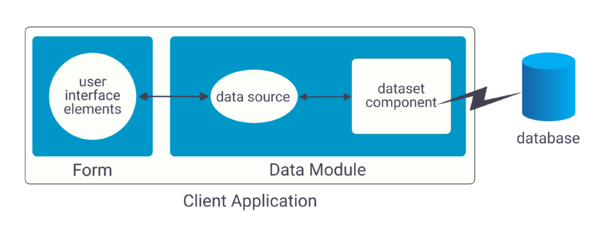Planning for Scalability
Go Up to Database Architecture
The development process can get more involved and expensive as the number of tiers increases. Because of this, you may wish to start developing your application as a single-tiered application. As the amount of data, the number of users, and the number of different applications accessing the data grows, you may later need to scale up to a multi-tiered architecture. By planning for scalability, you can protect your development investment when writing a single- or two-tiered application so that the code can be reused as your application grows.
The VCL data-aware components make it easy to write scalable applications by abstracting the behavior of the database and the data stored by the database. Whether you are writing a single-tiered, two-tiered, or multi-tiered application, you can isolate your user interface from the data access layer as illustrated in the following picture:
A form represents the user interface, and contains data controls and other user interface elements. The data controls in the user interface connect to datasets which represent information from the tables in the database. A data source links the data controls to these datasets. By isolating the data source and datasets in a data module, the form can remain unchanged as you scale your application up. Only the datasets must change.
A flat-file database application is easily scaled to the client in a multi-tiered application because both architectures use the same client dataset component. In fact, you can write an application that acts as both a flat-file application and a multi-tiered client (see Using the Briefcase Model).
If you plan to scale your application up to a three-tiered architecture eventually, you can write your one- or two-tiered application with that goal in mind. In addition to isolating the user interface, isolate all logic that will eventually reside on the middle tier so that it is easy to replace at a later time. You can even connect your user interface elements to client datasets (used in multi-tiered applications), and connect them to local versions of the datasets in a separate data module that will eventually move to the middle tier. If you do not want to introduce this artifice of an extra dataset layer in your one- and two-tiered applications, it is still easy to scale up to a three-tiered application at a later date. See Scaling Up to a Three-tiered Application for more information.
